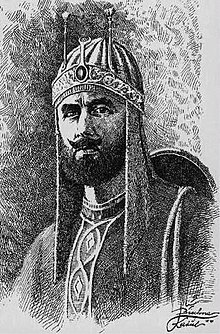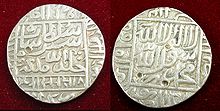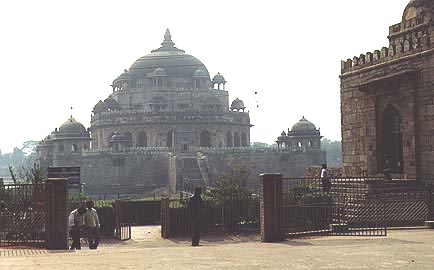1 Akhbar
2 Sher Shah Suri
3 Mian Hassan Khan
4 Bahlul Khan Lodi.
Ans : 2


Ruppiya released by Sher Shah Suri, 1540–1545 CE,
was the first Rupee
Sher Shah Suri, Sultan of the Suri Empire17 May 1540 – 22 May 1545
(5 years, 5 days)
"Rupee" is abbreviated as Re. (singular), Rs. (plural) and as
The rupee is the common name for the monetary unit of account in India, Pakistan, Sri Lanka, Nepal, Mauritius, Seychelles, Maldives, Indonesia (as the Rupiah), and formerly in Burma, and Afghanistan. Historically, the first currency called "rupee" was introduced in the 16th century by Sher Shah Suri, founder of the Sur Empire. The term is from rūpya-, a Sanskrit term for silver coin.
In the Maldives, the unit of currency is known as the rufiyah, which is a cognate word of Hindi rupiya. Both the Indian rupees and the Pakistani are subdivided into one hundred paise (singular paisa) or pice. The Mauritian and Sri Lankan rupees subdivide into 100 cents. The Nepalese rupee subdivides into one hundred paisas (both singular and plural) or four Sukas or two Mohors.
Afghanistan's currency was also denominated in Afghan rupees until 1925, with each Afghan rupee subdividing into 60 paisas. Prior to the introduction of the Afghan rupee in 1891, the legal currency was the Kabuli rupee. Until the middle of the twentieth century, Tibet's official currency was also known as the Tibetan rupee. The Indian rupee was the official currency of Dubai and Qatar until 1959, when India created a new Gulf rupee (also known as the "External rupee") to hinder the smuggling of gold. The Gulf rupee was legal tender until 1966, when India significantly devalued the Indian rupee and a new Qatar-Dubai Riyal was established to provide economic stability..
Sher Shah was born as Farid Khan in Sasaram (Bihar), in the Rohtas district. He was one of about eight sons of Mian Hassan Khan Sur, a prominent figure in the government of Bahlul Khan Lodi. Sher Khan belonged to the Pashtun Sur tribe (the Pashtuns are known as Afghans in historical Persian language sources).] His grandfather, Ibrahim Khan Sur, was a noble adventurer who was recruited much earlier by Sultan Bahlul Lodi of Delhi during his long contest with the Jaunpur Sultanate.
During his early age, Farid was given a village in Fargana, Shahabad (comprising present day districts of Bhojpur, Buxar, Bhabhua of Bihar) by Omar Khan, the counselor and courtier of Bahlul Khan Lodi. Farid Khan and his father, who had several wives, did not get along for a while so he decided to run away from home. When his father discovered that he fled to serve Jamal Khan, the governor of Jaunpur, Uttar Pradesh, he wrote Jamal Khan a letter that stated:
Jamal Khan had advised Farid to return home but he refused. Farid replied in a letter:
"If my father wants me back to instruct me in learning, there are in this city many learned men: I will study here."
Farid Khan started his service under Bahar Khan Lohani, the Mughal Governor of Bihar. Because of his valor, Bahar Khan rewarded him the title Sher Khan (Tiger Lord). After the death of Bahar Khan, Sher Khan became the regent ruler of the minor Sultan, Jalal Khan. Later sensing the growth Sher Shah's power in Bihar, Jalal sought assistance of Ghiyasuddin Mahmud Shah, the independent Sultan of Bengal. Ghiyasuddin sent an army under General Ibrahim Khan. But Sher Khan defeated the force at the battle of Surajgarh in 1534. Thus he achieved complete control of Bihar.
In 1538, Sher Khan attacked Bengal and defeated Ghiyashuddin Shah.] But he lost to capture the kingdom because of sudden expedition of Emperor Humayun. In 1539, Sher Khan faced Humayun in the battle of Chausa. He forced Humayun out of India. Assuming the title Sher Shah, he ascended the throne of Delhi
Sher Shah rebuilt the longest highway in South Asia. The highway was called the Shahrah-e-Azam (also Sadak-e-Azam, Badshahi Sadak and later Grand Trunk Road by the British). It is still in use in present-day Khyber Pakhtunkhwa, Punjab region Punjab, Delhi, Uttar Pradesh, Bihar and Bengal.
The system of tri-metalism which came to characterize Mughal coinage was introduced by Sher Shah. While the term rūpya had previously been used as a generic term for any silver coin, during his rule the term rūpiya came to be used as the name for a silver coin of a standard weight of 178 grains, which was the precursor of the modern rupee. Rupee is today used as the national currency in Pakistan, India, Nepal, Sri Lanka, Indonesia, Mauritius, Maldives, Seychelles among other countries. Gold coins called the Mohur weighing 169 grains and copper coins called Dam were also minted by his government.
Sher Shah built monuments including Rohtas Fort (now a UNESCO World Heritage Site in Pakistan), many structures in the Rohtasgarh Fort in Bihar, Sher Shah Suri Masjid, in Patna, built in 1540–1545 to commemorate his reign.
Qila-i-Kuhna mosque, built by Sher Shah in 1541, at Purana Qila, Delhi, a Humayun citadel started in 1533, and later extended by him, along with the construction of Sher Mandal, an octagonal building inside the Purana Qila complex, which later served as the library of Humayun.
Tarikh-i-Sher Shahi (History of Sher Shah), written by Abbas Khan Sarwani, a waqia-navis under later Mughal Emperor, Akbar around 1580, provides a detailed documentation about Sher Shah's administration.

Sher Shah Suri Tomb at Sasaram
Sher Shah died from a gunpowder explosion during the siege of Kalinjar fort on May 22, 1545 fighting against the Chandel Rajputs. His death has also been claimed to have been caused by a fire in his store room.
Sher Shah Suri was succeeded by his son, Jalal Khan who took the title of Islam Shah Suri. His mausoleum, the Sher Shah Suri Tomb (122 ft high) stands in the middle of an artificial lake at Sasaram, a town that stands on the Grand Trunk Road.
Really so informative blog I like it.
ReplyDeleteThank You,
Commodity Tips Provider
waoo nice post about Who has dicovered Rupiya ( current Indian Currency )
ReplyDeleteThanks,